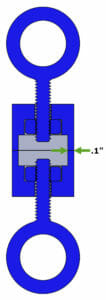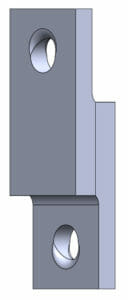
This 3D Printing Glue Strength Guide was built due to questions we have repeatedly gotten from customers over the years when they are planning to glue 3D Printed parts they have sourced from us together after they receive them. The most common questions are:
- What type of adhesives would we recommend for bonding 3D printed parts together (especially when they are used to join dissimilar materials)?
- What kind of strength can be be anticipated when using a glue joint on an assembly of 3D printed parts?
In order to do this testing we printed the same base part in a large number of the most common materials we produce parts in for our customers:
- MJF – (NYLON) PA-12
- MJF – M95A TPU
- SLS – (NYLON) PA-12
- SLS – (NYLON) PA-12 GB
- SLA – ACURA ClearView
- SLA – ACURA 25
- PolyJet – VERO CLEAR
- CLIP – EPX82
- FDM – ABS
The glue joint design that was settled on was one that is considered a worst case scenario from a strength perspective, its called a butt joint. The flat area that made up the butt joint was .1″ wide, this is a common thickness we see for these types of joints and also acts as a worst case scenario due to its small size. For a look at other types of glue joints that are much stronger check out our HP Multi-Jet Part Design Guide and look at the section titled: “Glue Joints”.
We put both of these questions to the test with a collection of tensile strength and shear strength pull tests designed to come up with an approximate breaking force for each combination of materials. Check out the following videos and tables to see the results:
Tensile Strength Pull Test
| Printed on A | Material A | Printed on B | Material B | Break Force |
| MJF | (NYLON) PA-12 | SLA | Acura ClearView | 122 LBS |
| MJF | M95A TPU | SLA | Acura ClearView | 121 LBS |
| MJF | M95A TPU | PolyJet | Vero Clear | 116 LBS |
| SLS | (NYLON) PA-12 | SLA | Acura ClearView | 139 LBS |
| MJF | (NYLON) PA-12 | PolyJet | Vero Clear | 148 LBS |
| MJF | (NYLON) PA-12 | SLS | (NYLON) PA-12 | 250 LBS |
| CLIP | EPX82 | MJF | M95A TPU | 102 LBS |
| MJF | (NYLON) PA-12 | CLIP | EPX82 | 266 LBS |
| MJF | (NYLON) PA-12 | MJF | M95A TPU | 96 LBS |
| MJF | (NYLON) PA-12 | MJF | (NYLON) PA-12 | 176 LBS |
| SLA | Acura ClearView | SLA | Acura ClearView | 100 LBS |
Shear Strength Pull Tests
| Printed on A | Material A | Printed on B | Material B | Break Force |
| MJF | (NYLON) PA-12 | MJF | (NYLON) PA-12 | 115 LBS |
| MJF | M95A TPU | MJF | M95A TPU | 169 LBS |
| MJF | M95A TPU | SLA | Acura 25 | 122 LBS |
| SLA | Acura 25 | SLA | Acura 25 | 190 LBS |
| SLA | Acura 25 | MJF | (NYLON) PA-12 | 131 LBS |
| FDM | ABS | MJF | M95A TPU | 174 LBS |
| FDM | ABS | FDM | ABS | 394 LBS |
| FDM | ABS | MJF | (NYLON) PA-12 | 105 LBS |
| CLIP | EPX82 | MJF | (NYLON) PA-12 | 157 LBS |
| CLIP | EPX82 | CLIP | EPX82 | 405 LBS |
| CLIP | EPX82 | MJF | M95A TPU | 183 LBS |
| SLS | (NYLON) PA-12 | MJF | M95A TPU | 191 LBS |
| SLS | (NYLON) PA-12 | SLA | Acura 25 | 161 LBS |
| SLS | (NYLON) PA-12 | MJF | (NYLON) PA-12 | 138 LBS |
| SLS | (NYLON) PA-12 GB | MJF | M95A TPU | 184 LBS |
| SLS | (NYLON) PA-12 GB | SLS | (NYLON) PA-12 GB | 280 LBS |
| SLS | (NYLON) PA-12 GB | MJF | (NYLON) PA-12 | 200 LBS |
3D Printing Glue Strength: Adhesive Recommendation
Based on our research prior to filming this test we narrowed down the best all around glue to Loctite HY4070. It had the best average holding power across all of the different material and printing processes we tested it on verse other epoxies and super glues. This glue is also commonly available and can be found on amazon.com.




